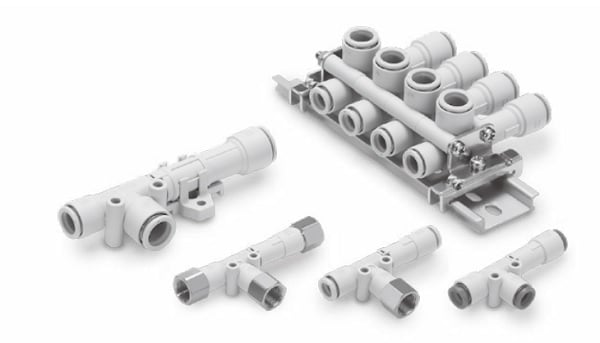Understanding Single-stage vs. Multi-stage Pneumatic Devices
This article looks at vacuum ejectors and vacuum pumps, specifically outlining the difference between single and multi-stage versions of each type, and common applications.
Vacuum Components
Vacuum pumps and vacuum ejectors are a common type of equipment found in many manufacturing and automation processes. Vacuum ejectors create a vacuum through the use of the Venturi effect, while pumps consist of mechanical vanes driven by a motor, moving air to create the vacuum.
Pumps and ejectors can both be used in either single or multistage configurations. Single-stage configuration involves a pump or ejector in its simplest form and consists of only a single action or “stage” of vacuum/pressure generation. Multi-stage pumps/injectors involve the combination of two or more devices that change the pressure inside.
Comparing Vacuum Pumps and Ejectors
The advantages and disadvantages of each will be discussed in detail in subsequent sections. Vacuum ejectors are generally much cheaper and smaller than vacuum pumps but cannot create vacuum levels as high as a pump. Ejectors also need to use compressed air to function, and compressed air availability is something that should be considered in the design process. Pumps can create higher volume and higher vacuum but are much more complicated than ejectors, plus more expensive and larger.
The specifics of each should be taken into consideration when designing a system that utilizes a vacuum.
Single-Stage Ejectors
Single-stage ejectors are a common vacuum generation device for automation, mainly used in pick-and-place solutions. They consist of a housing that uses compressed air to create a vacuum by taking advantage of the Venturi effect.
Single-stage ejectors have the advantage of simplicity and can create a stronger vacuum when compared to multi-stage ejectors. This means they are useful in applications that require heavy lifting, especially pick and place where constant vacuum is not necessary. Single-stage ejectors can handle a certain amount of dirt and debris from the product since there are no moving parts and no air filter to plug with cardboard particles etc.

Figure 1. Body-ported type single-stage ejectors are compact and fit easily into tight spaces. Image used courtesy of SMC USA
Multi-Stage Ejectors
Multi-stage vacuum ejectors consist of multiple Venturi ports that function together to create the needed vacuum level. The combination of more than one Venturi gives multi-stage ejectors a much faster response time than single-stage ejectors when creating the lower pressure. However, they are not able to create as high of a vacuum as a single-stage Venturi ejector. Multi-stage ejectors are common in pick-and-place applications where speed is a more critical concern than strength, like populating SMT PCB components.
The ability to create a vacuum in less time means that cycle times can often be reduced in systems with the addition of a multi-stage ejector. The only caveat to multi-stage ejectors is that the handled material cannot be too heavy, or else the vacuum may not be able to lift it.
Vacuum Pump Overview
In addition to Venturi-based ejectors, vacuum suction can be created with the use of a vacuum pump. Pumps can also be single or multi-stage, each with a unique set of pros and cons. Vacuum pumps operate using mechanical components to evacuate air or liquid from the intake side of the pump. Pumps are used in high vacuum and high flow rate applications, and can often be found in many manufacturing environments.
Pumps are often used in clean room applications since there is no water intrusion from a central compressed air source. Pumps are generally driven by an electrical motor and may achieve higher efficiencies over Venturi pumps which use compressed air.
Single-Stage Pumps
Single-stage Vacuum pumps are used to create a high vacuum and high flow rate. They consist of a pump driven by a motor, generally an electric motor. The pump may consist of one of three types:
- Positive displacement pump
- Momentum transfer pump
- Entrapment pump
Single-stage pumps can be used to create low vacuum or high vacuum and there are many different sizes and types available to suit individual applications. Single-stage pumps offer a much higher volume than that of vacuum ejectors. The downside is the increased cost of a pump and the larger overall size of the system.

Figure 2. Vacuum pumps use vanes or lobes to create a vacuum. Image used courtesy of Adobe Stock
Multi-Stage Pumps
Multi-stage vacuum pumps are used to create ultrahigh vacuum (understanding, of course, that the highest vacuum that can be created is 0 psi, or 0 bar). They often use two sets of vanes or blades in tandem, essentially creating two vacuum pumps in one. The first vacuum consists of a high vacuum configuration. The initial stage creates an ultrahigh vacuum and pumps the gas to the next stage. It is able to create a higher vacuum because it is pumping into a vacuum, i.e. the second stage of the pump.
The second stage of a two-stage vacuum pump is another set of vanes that creates a lower vacuum than the initial stage of the pump. It takes the gas from the high vacuum first stage and then exhausts it back to the environment. Multi-stage pumps can create the highest vacuum level among any of the systems discussed here, and they are useful in applications that require ultra-high vacuum.
Vacuums: Lowering Air Pressure to Create Work
Vacuum is an important part of many manufacturing processes. It is useful in packaging, food and beverage, electronics manufacturing, automotive, and a multitude of other industries. The broad range of applications for vacuum means that different mechanisms for creating a vacuum are available. It can be important when designing a system or troubleshooting an existing system, to understand the limitations and strengths of each system.
Vacuum ejectors are used to create low vacuum at low volumes. They use the Venturi effect to create a vacuum in either single or multi-stage configurations. Single-stage ejectors create higher vacuum levels, but multi-stage ejectors are faster at creating that vacuum. Vacuum pumps consist of a mechanical vacuum pump driven by an electrical motor to produce the vacuum. They are capable of creating high vacuum and multi-stage vacuum pumps can create ultra-high vacuum. Vacuum pumps can be used in cleanroom applications.






